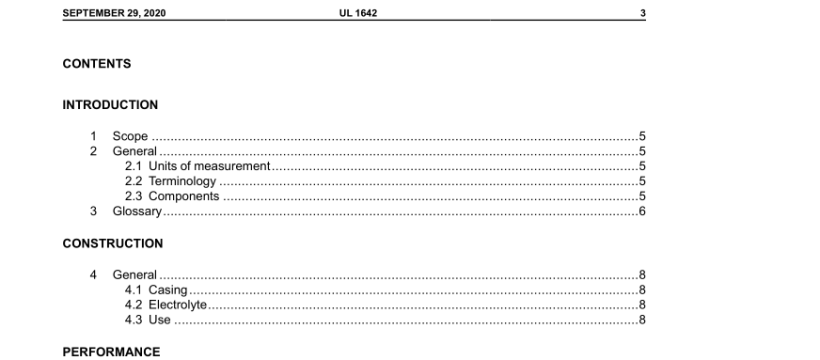UL 1666-2021 pdf download.Test for Flame Propagation Height of Electrical and Optical-Fiber Cables Installed Vertically in Shafts.
2 Units of Measurement 2.1 Values stated without parentheses are the requirement. Values in parentheses are explanatory or approximate information. PERFORMANCE 3 Fire Test Room 3.1 The fire test room in which the chamber is located is to have provision for a free inflow of air to maintain the room at a controlled pressure of 0 – 0.05 in (0 – 12 Pa) of water column with respect to barometric pressure and at a temperature of 73 ±5°F (23 ±3°C) and a relative humidity of 50 ±5 percent throughout each test. 4 Fire Test Apparatus 4.1 Fire test chamber 4.1.1 The test chamber is to be as shown in Figure 4.1. The test chamber, all equipment, and the cable specimens are to be protected from the wind and other conditions of weather that could affect the test results. The walls of the structure are to be of standard concrete masonry nominally 8 in (203 mm) thick. The first and second floors shall be constructed of reinforced normal-weight concrete nominally 5 – 8 in (127 – 203 mm) thick. The roof shall be constructed of a suitable building construction capable of providing a tight seal with the walls of the structure. A slot measuring 1 ft by 2 ft (305 mm by 610 mm) is to be located in the first floor, and an identical slot is to be located directly above in the second floor. As shown in Figure 4.1, each slot is to be 8 in (203 mm) from the back wall of the room and 4 in (102 mm) from the side wall of the room. The slots are to be oriented adjacent to either side wall of the room based on installation and position of the fire test chamber. Windows are to be positioned as needed for observation. 4.1.2 The test chamber is to contain steel access doors located on the first and second floors as shown in Figure 4.1 or positioned in any of the other walls. Positioning the second floor door or an additional access hatch in the wall opposite the slot is advantageous as this allows for ease of installation of the cable specimens and positioning of second floor slot thermocouples. The size of each access is not specified.
4.3 Burner fan 4.3.1 An electric blower fan capable of providing an air velocity across the burner outlet as specified in 8.3 is to be positioned outside the chamber perpendicular to the centerline of the burner as shown in Figure 4.1. A slot that is 6 in wide by 4 in high (152 mm by 102 mm) is to be provided in the wall of the test chamber at the first floor level to enable the fan to move air across the burner. 4.4 Propane 4.4.1 The gas supplied to the burner is to be CP-grade propane having a nominal heating value of 2500 Btu (thermochemical) per cubic foot [93.0 MJ/m 3 or 22.2 kilocalories (thermochemical) per cubic meter]. 4.5 Exhaust blower and duct 4.5.1 A steel exhaust duct is to be positioned in the center of the roof of the fire test chamber as shown in Figure 4.1. An exhaust blower is to be connected to the exhaust duct. The blower is to have the capacity to maintain the required air velocity specified in 8.2 throughout the duration of the test. 4.6 Temperature and flow measurement instrumentation 4.6.1 Eight 28 AWG Type K thermocouples with an inconel sheath are to be located in the slot in the second floor, and one thermocouple is to be located in the first floor slot, as shown in Figure 4.4. 4.6.2 One 28 AWG Type K thermocouple with an inconel sheath is to be located at the centerpoint of the first floor chamber ceiling and is to extend downward 1 ±1/16 in (25.4 ±1.6 mm) perpendicular to the ceiling. This thermocouple is used to determine the test chamber temperature prior to conducting a test. 4.6.3 A bi-directional air-velocity probe is to be located at the horizontal and vertical center (]·[) of the first floor slot as shown in Figure 4.4. The velocity probe for flow measurements is to be connected to an electronic pressure gauge to obtain differential pressure.
4.7 Data acquisition equipment 4.7.1 A digital data acquisition system shall be used to collect and record the air inlet slot velocity and second floor slot thermocouple temperature at intervals of 5 seconds or less. 5 Specimen Conditioning 5.1 Prior to testing, all cable specimens are to be conditioned for a minimum of 24 h in a controlled environment of 73 ±5°F (23 ±3°C) and relative humidity of 50 ±5 percent. Samples which are supplied on reels shall have any wrapping materials removed before conditioning. 6 Determination of Specimen Diameter 6.1 Use either a diameter tape, vernier caliper, or a micrometer with an accuracy of 0.001 in (0.025 mm) to measure the specimen diameter. 6.2 The diameter tape is appropriate for specimens that are uniformly round. Ensure that the tape is wrapped tightly around the specimen, but not so tight that the specimen is compressed. Use an arithmetic average of three readings over a 1 ft (0.3 m) length of the specimen as the specimen diameter. 6.3 The vernier caliper is appropriate for all sizes of cable specimens, and is especially useful for small diameter cables which are not uniform in cross section.UL 1666-2021 pdf download.
UL 1666-2021 pdf download
